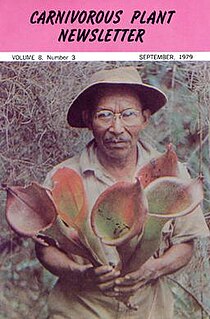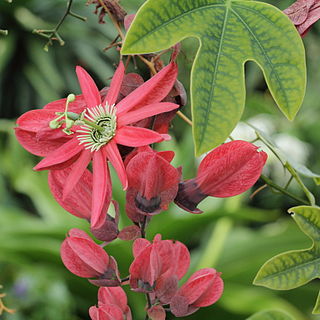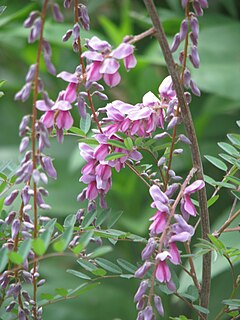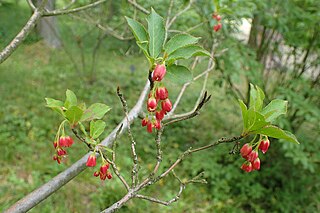
The Royal Horticultural Society (RHS), founded in 1804 as the Horticultural Society of London, is the UK's leading gardening charity.

The Award of Garden Merit (AGM) is a long-established annual award for plants by the British Royal Horticultural Society (RHS). It is based on assessment of the plants' performance under UK growing conditions.

The Carnivorous Plant Newsletter is the official publication of the International Carnivorous Plant Society (ICPS), the largest such organization in the world. It is headquartered in Walnut Creek, California.

RHS Garden Hyde Hall is a public display garden run by the Royal Horticultural Society in the English county of Essex. It is one of five public gardens run by the Society, alongside Wisley in Surrey, Harlow Carr in North Yorkshire, Rosemoor in Devon, and Bridgewater in Greater Manchester.

Passiflora racemosa, the red passion flower, is a species of flowering plant in the family Passifloraceae, native to Brazil. It is an evergreen climber growing to 5 m (16 ft), with simple or 3-lobed leaves to 10 cm (4 in) long, and vivid red flowers borne in summer. The flowers are 12 cm (5 in) in diameter, with purple and white coronas. They are followed by oblong green fruits.

The International Pinguicula Study Group Newsletter was the official publication of the International Pinguicula Study Group, a Pinguicula society based in the United Kingdom that was active during the 1990s. Typical articles included matters of horticultural interest, field reports, and scientific studies. Only 10 issues were ever released and the newsletter had an irregular publication history. In chronological order, the 10 issues were: volume 1, volume 2, volume 3, volume 4, volume 5, volume 6, volume 7, volume 8, volume 9, and volume 10. The International Carnivorous Plant Society hosts an online archive of all ten issues.

Eriocapitella × hybrida is a hybrid of flowering plants in the buttercup family Ranunculaceae. The parents of the hybrid are E. japonica and E. vitifolia. Cultivars of the hybrid are commonly known as Japanese anemone hybrids.

Plectranthus ciliatus, called Indian borage, speckled spur flower, blue spur flower, and candlestick plant, is a species of flowering plant in the family Lamiaceae. It is native to South Africa and Swaziland, and introduced to Victoria in Australia and the North and South Islands of New Zealand. With its Coleus‑like foliage, its cultivar 'Easy Gold' has gained the Royal Horticultural Society's Award of Garden Merit as an ornamental.

Bergenia purpurascens, the purple bergenia, is a species of flowering plant in the family Saxifragaceae, native to Nepal, the eastern Himalayas, Assam, Tibet, south-central China, and Myanmar. The species, its putative variety Bergenia purpurascens var. delavayi, and its cultivar 'Irish Crimson' have all gained the Royal Horticultural Society's Award of Garden Merit. A useful feature in the garden is the visual interest that its foliage provides by turning a deep beet red during the winter.

Kohleria warszewiczii is a species of flowering plant in the family Gesneriaceae, native to Colombia. It has gained the Royal Horticultural Society's Award of Garden Merit.

Cyanotis beddomei, the teddy bear vine, is a species of flowering plant in the family Commelinaceae, native to Kerala and Tamil Nadu states in southern India. It has gained the Royal Horticultural Society's Award of Garden Merit. It may be synonymous with Belosynapsis kewensis.

Indigofera pendula, the weeping indigo, is a species of flowering plant in the family Fabaceae, native to south-central China. Its cultivar 'Shangri-la' has gained the Royal Horticultural Society's Award of Garden Merit.

Neopanax laetus, the shrub panax, is a species of flowering plant in the subfamily Aralioideae, family Araliaceae, native to the North Island of New Zealand. It has gained the Royal Horticultural Society's Award of Garden Merit.

Ranunculus montanus, called the mountain buttercup along with other members of its genus, is a species of flowering plant in the family Ranunculaceae, native to the mountains of central and south-central Europe, with perhaps some populations in the Republic of Karelia in Russia. Its cultivar 'Molten Gold' has gained the Royal Horticultural Society's Award of Garden Merit.

Lysimachia barystachys, the Manchurian yellow loosestrife, is a species of flowering plant in the family Primulaceae. It is widely distributed in northern, eastern and central China, Far Eastern Russia, the Korean Peninsula and Japan, and has been introduced in the US state of Georgia. It has gained the Royal Horticultural Society's Award of Garden Merit.

Sorbaria tomentosa, the Himalayan sorbaria or Kashmir false spirea, is a species of flowering plant in the family Rosaceae. It is native to Afghanistan, Central Asia and the Himalayas, and has been introduced to the South Island of New Zealand. It has gone extinct in Tajikistan. Its putative variety Sorbaria tomentosa var. angustifolia, the narrow-leaved Himalayan sorbaria, has gained the Royal Horticultural Society's Award of Garden Merit.

Plectranthus madagascariensis, called thicket coleus, Madagascar coleus and candle plant, is a species of flowering plant in the family Lamiaceae. It is native to South Africa, eSwatini, Mozambique, Mauritius and Réunion, but not Madagascar. Its cultivar 'Variegated Mintleaf' has gained the Royal Horticultural Society's Award of Garden Merit.

Enkianthus cernuus, the nodding enkianthus, is a species of flowering plant in the family Ericaceae, native to southern Japan. A shrub or small tree that prefers to grow in wet areas, its putative form Enkianthus cernuus f. rubens, the drooping red enkianthus, has gained the Royal Horticultural Society's Award of Garden Merit.
Phlomis grandiflora, called Jerusalem sage along with a number of other species, is a flowering plant in the family Lamiaceae, native to the eastern Aegean Islands and Turkey. Its cultivar 'Lloyd's Silver' has gained the Royal Horticultural Society's Award of Garden Merit as an ornamental.

















